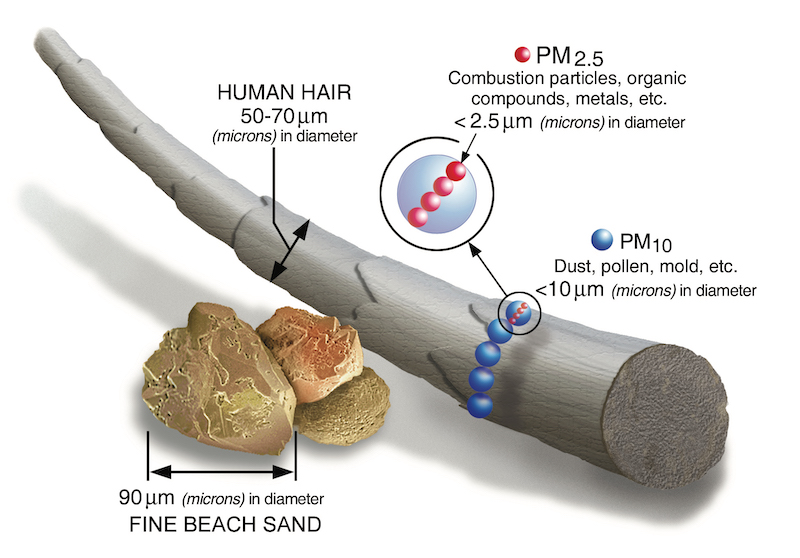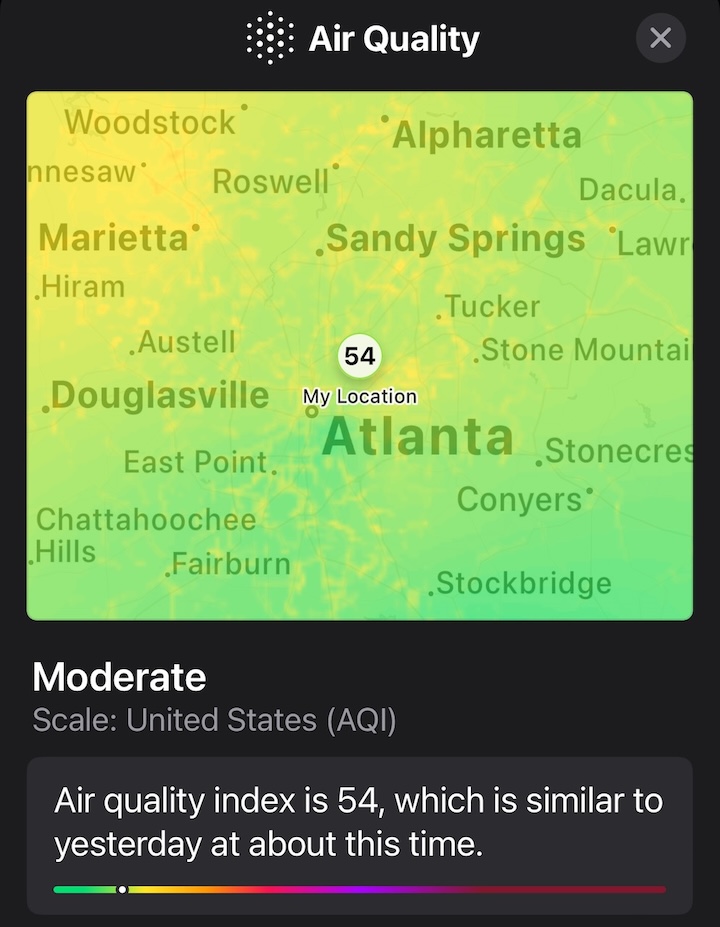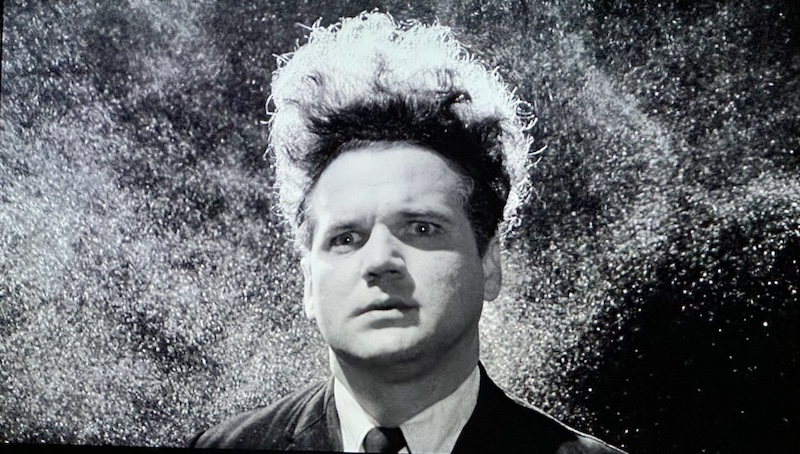A Vivid Look at the Effects of Air Pollution

This week I saw a photo that will haunt me for the rest of my life. It’s one thing to know something. It’s another to see it. I’ve been writing about indoor air quality and the health effects of indoor air pollutants for a long time now. And I’ve been stressing how important it is to reduce the amount of particulate matter, especially the really small stuff, that we inhale. Now there’s a research study out that shows the effects of air pollution on the human body.
Particulate matter
Researchers who study the effects of air pollution point to a lot of different pollutants as problems for our health. One of the top air pollutants they mention is usually referred to simply as PM2.5, which stands for particulate matter that’s 2.5 microns or smaller. This sketch from the US EPA shows how it compares in size to a human hair or grains of sand.

There’s a good reason the tiny invisible particles floating around in the air are so much worse than the larger ones. Because they’re so small, they can penetrate deeper into our respiratory system. The big ones get stopped in your nose or throat. The small ones make it all the way to your lungs.
OK, so what happens when those tiny particles get into your lungs?
A look at lymph nodes
The recent study I referred to is from the scientific journal Nature. (You can read a short summary or the whole article.) The researchers took sample lymph nodes from deceased organ donors of different ages. Why lymph nodes? As they say in the summary, lymph nodes are an important part of our immune system, and they “filter impurities and coordinate the clearance of harmful antigens and pathogens.”
Now, that haunting photo I mentioned above is the one just below. It shows a panel of the lymph nodes associated with the lungs from people of different ages.

![A different look at damaged lymph nodes showing the effects of air pollution [Nature, Vol. 28, Dec. 2022, pp. 2482-3]](https://www.energyvanguard.com/wp-content/uploads/2024/01/air-pollution-particulate-effect-on-lymph-nodes-b.jpg)
Naturally, you’re probably wondering what we know about the people who donated their lymph nodes for this study. According to the paper, they were from the New York metropolitan area and were “non-smokers and/or with no history of heavy smoking.” We don’t know, however, if any of the donors had significant exposure to particulate matter in their jobs.
What can you do?
The first thing you can do to protect yourself is to be mindful of what you’re breathing. If you work in an environment with a high potential for exposure to particulates, you better have some good personal protective equipment (PPE). Don’t be afraid to wear a mask and respirator just because no one else is.
Also, check the air quality when you’re planning outdoor activities. The good news is that weather apps make this easy to find. Below is the one I see in my iPhone weather app. The EPA developed the Air Quality Index and has a table showing what the colors and numbers mean. Even better, though, Vox has a nice article showing how to use the Air Quality Index.

And then there’s indoor air. You can monitor the carbon dioxide level to get an idea of how much dilution you’re getting through air changes with outdoor air. You also can get good inexpensive indoor air quality monitors that tell you that and also the PM2.5 level indoors. I’ve got two Awair Elements* in my house and also a couple of Airthings for Business monitors.
But monitoring tells you only how bad the air might be. To do something about particulates in your indoor air, you need good filtration. And on that topic, I’ve got you covered. Start with my article, 3 Ways to Get Cleaner Indoor Air With Filtration, and you’ll find a lot of guidance on how to get the particles out of your indoor air.
Mind blown
I don’t know about you, but that first image I posted above from the research paper is mind-blowing to me. Unlike that cloud of particulates around Henry Spencer, though, the ones that turn your lymph nodes black are the ones you can’t see.

They say a picture is worth a thousand words. I guess it must be true because I just wrote about a thousand words here because of that one picture.
Allison A. Bailes III, PhD is a speaker, writer, building science consultant, and the founder of Energy Vanguard in Decatur, Georgia. He has a doctorate in physics and is the author of a bestselling book on building science. He also writes the Energy Vanguard Blog. For more updates, you can subscribe to Energy Vanguard’s weekly newsletter and follow him on LinkedIn.
Related Articles
Which Indoor Air Pollutants Matter Most?
A Layered Approach to Indoor Air Quality
3 Ways to Get Cleaner Indoor Air With Filtration
* This is an Amazon Associate link. You pay the same price you would pay normally, but Energy Vanguard may make a small commission if you buy after using the link.
Comments are welcome and moderated. Your comment will appear below after approval.
This Post Has 17 Comments
Comments are closed.

Great post Allison. Happens to be #200, happy 200th! Thanks for continuing to hammer on this topic, it deserves much more attention. Canada was on fire this Summer and the outdoor air was rich with PM2.5. Now it is Winter and many neighbors have their wood stoves filling the air with same-same. The more attention we draw to this the better.
Thanks Allison! Great article and am sharing it widely. Mind blown also by that first image.
Humans did not evolve to live in a dust-free environment. They evolved to live in an often-dusty environment. The fact that lymph nodes have sequestered (inert) carbon particles does not prove they are damaged in any way. It merely proves they have been doing their job keeping bronchial epithelial and alveolar linings clean.
4 statements – zero citations; which makes them mere opinions.
What is the point you are trying to make?
Reference the #1 statement – – – “did not evolve to live in a dust-free environment” does not prove in any way that humans evolved to safely breathe 2.5PM sized particles during their everyday inhalations. Actually, the term “dusty”, from a science perspective, is really meaningless. Please define “dusty”.
Roy, I think the point from John F was – the paper doesn’t include any “science”. It expresses nothing more than conjecture and opinions based on limited epidemiological observation.
I am not saying breathing clean air isn’t supportive of better health. But any assertions made in the name of science should include some reliance on the “scientific method” we were taught in grade school.
I believe truth and honesty are important. That’s why we should be careful about changing the meaning of words and terms to promote specific agendas, even those which might be seen as beneficial.
Just my opinion. Others may disagree.
Precisely, John Foster. Well said. The paper is pure pseudo science.
Danny: It’s easy to throw the pseudoscience label around when you don’t cite any proof. I’ve read the summary and a lot of the full paper and see no evidence to support your claim.
Allison, You are 100% correct. It’s real easy. All that’s required is to read the definition and see if the paper fits. The controlling element is found in #3. #1 and #2 are irrelevant without it. Of course if we don’t like that definition, we can change it. It happens all the time.
pseudoscience /soo͞″dō-sī′əns/
noun
1. A theory, methodology, or practice that is considered to be without scientific foundation.
2. False or pretended science; a pretended science.
3. Any body of knowledge purported to be scientific or supported by science but which fails to comply with the scientific method.
Danny: Since you’ve once again cited no evidence to support your claim, I’m going to assume it’s because you have none.
Danny: Based on some of the stuff I’ve seen you post on LinkedIn, it seems you have a bias against the medical profession, but what’s your beef here? Are you saying that particulate matter doesn’t cause health problems? That air pollution isn’t bad for you? There’s a ton of research in that field showing otherwise. Here are just a few sources on that:
American Lung Association: https://www.lung.org/clean-air/outdoors/what-makes-air-unhealthy/particle-pollution
US EPA: https://www.epa.gov/pm-pollution/health-and-environmental-effects-particulate-matter-pm
NIH paper: https://www.ncbi.nlm.nih.gov/pmc/articles/PMC9223652/
NIH paper: https://www.ncbi.nlm.nih.gov/pmc/articles/PMC4740125/
Berkeley Lab: https://newscenter.lbl.gov/2013/04/10/hidden-dangers-in-the-air-we-breathe/
John: One could also say that humans didn’t evolve to live more than 30 years old, since that was about as long as they lived during all those millennia of evolution. And the body doesn’t have disposable, replaceable lymph nodes. The ones we have are all we get. Clog them, and they won’t work as well.
Good news Allison. Lymphatic tissue is replaced or regenerated. Depending on the literature and the “terrain”, it can occur in a few weeks to several months. We are fearfully and wonderfully made.
If the “inert” carbon in the lymph notes was indeed truly inert that might be a different story. But when that really fine particulate (< 1.0u) is looked at and chemically analyzed – it is often carrying with it heavy metals. Metals from inside of engines – sometimes cadmium from bearing surfaces.
Equally as bad is that the really fine stuff can cross over from the lungs into the blood stream, across the placenta and into the developing fetus.
How inert does inert have to be? Fine particulate almost always coagulates with other fine particulates bringing into the lungs stuff that we would choose not to eat – because we know the impacts to our biological systems are very bad.
Humans now live a lot longer than we did recently. Our organs now have to endure longer than evolution intended.
I live with my family in Hanoi. I run IQAir and Xiaomi air purifiers 24/24 in my house, and only open doors and windows on those rare occasions when outdoor conditions are reasonably good. Nevertheless the indoor air quality frequently remains at dangerous levels. I include a photo of the IQAir monitor readings for indoor and outdoor air quality at 6:30am. This level is typical and becomes more serious during the day.
Ian, be careful with “purifiers” vs filters. Allison has addressed issues with purifiers more than once on this blog, I believe.
In response to your post, “Since you’ve once again cited no evidence to support your claim, I’m going to assume it’s because you have none.”
Please refer to the age old maxim, the proponent ALWAYS bears the burden of proof.
OR as Sagan liked to say, “”extraordinary claims require extraordinary evidence”.
Start with the basics. Where are the dependent and independent variables? If we keep labeling this stuff (although interesting) as science, we won’t learn a thing.